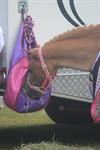Horse Feeding
When considering appropriate food for horses, we really need to understand factors which affect a horse’s individual requirements. These include:
- age and health,
- body weight and general condition,
- amount of work the horse is required to do,
- whether or not the horse’s living environment enables it to source feed naturally and is plentiful or if food is rationed and controlled by the owner or trainer, for example.
 Nutrients are obtained from carbohydrates, fat and protein. Horses also require vitamins, minerals and a plentiful source of fresh, clean water. There are simple calculations which can and should be used to establish the correct amount of feed based on each horse’s own individual requirements.
Nutrients are obtained from carbohydrates, fat and protein. Horses also require vitamins, minerals and a plentiful source of fresh, clean water. There are simple calculations which can and should be used to establish the correct amount of feed based on each horse’s own individual requirements.
The total amount of food a horse needs on a daily basis depends on its body weight and condition. The easiest way to measure a horse’s body weight, if appropriate scales are not available, is to use a commercial weigh tape. These can be bought from specialist horse feed suppliers. The weigh tape is placed around the horse’s barrel, just behind the elbow. It will give a fairly accurate body weight reading which you can then use to base the amount of food on.
Horses generally need to be fed between 1.5%-3% of their body weight in food daily. A native pony who is a ‘good doer’ may only need 1.5% of its body weight in feed while a rangier, naturally lighter thoroughbred for example may need closer to 3% of its body weight.
As an example, a 500kg horse will need between 7.5kg and 15kg of feed a day. Once an appropriate total amount of feed has been calculated, the amount needs to be split into a roughage ration and a concentrate ration. This calculation depends very much on the type of work the horse does.
As an example only, a 500kg horse, in good condition with no health problems and in light work (say 1 hour of work each day in walk, trot and canter) will need a total daily ration of 10kg of food (based on 2% of its bodyweight). This amount is split into 8kg of roughage and 2 kg of concentrates.
Roughage (Forage)
Grass is the most common forage food and will provide the horse with essential nutrients including carbohydrates, proteins and vitamins. Minerals are also available to horses from grass; however, the quantity and sort vary depending on soil quality and location. Grass quality also changes throughout the seasons. So, for example after long growing period throughout spring and summer, grass will contain more fibre and fewer nutrients.
Hay or dried grass (dried to 5-15% moisture) is also commonly fed as forage. This is normally lucerne or grass (it can be greener depending on the length of drying time). The quality of hay fed is extremely important and hay should never be mouldy or dusty, which can lead to digestive upsets and respiratory problems. The hay quality can be affected by the way it is stored, what species is used and when in the harvesting season it was originally cut.
Concentrates
Concentrate feeds provide additional energy and protein in the diet and are particularly important for horses in hard work, young growing animals and pregnant mares. Concentrates can be divided into two groups: straight cereal grains or manufactured compound feeds e.g. mixes/pellets/cubes.
Rationing of concentrates should be carefully considered as otherwise the horse may experience stomach upset and changes in behaviour. The horse has a relatively small stomach, so no more than 2.5kg of concentrates should be fed at any one time – this should be adjusted according to the size of the horse also. When introducing new concentrates into the diet, introduce small amounts at a time to the horses existing ration.
The most common straight cereal grains fed to horses are oats and barley.
Oats
Oats are a natural whole food for horses that provide lots of energy, as well as helping to condition the horses coat and hooves. They do not provide all the nutrients required however and an additional mineral and vitamin supplement may also be needed. Amino-acids lysine and methionine are also worth adding as they are low in oats. Oats can be quite heating for some horses, resulting in changes to temperament and ‘ride-ability’, so introduce slowly to prevent problems occurring.
Barley
Barley is more energy dense than oats. Again, certain minerals are lacking – the ratio of calcium and phosphorus in barley is the opposite of what is required by horses so supplements are normally recommended. Additionally, vitamins A and D are lacking from barley so vitamin supplements are essential. Barley is particularly useful to put additional body weight onto an underweight horse.
Learn more about Horses with ACS
Learn about the care and management of horses with ACS, with a selection of distance learning courses available to start at any time. We have courses suitable for students with different levels of existing knowledge, and appropriate to studies focussing on different areas of equine care, including feed and nutrition, equine behaviour, and horse breeding.
Do you love horses and want to know more, or are you looking to develop your career in the equine industry with quality training? Learn from our highly knowledgeable Equine tutors; if you want to know more, or need help in choosing a suitable course - submit your questions to our Equine tutors today. Or, phone us on (UK) 01384 442752 or (International) +44 (0) 1384 442752.
[29/12/2025 07:34:12]
More from ACS
Directory to dozens of courses include short courses, certificates and diplomas.